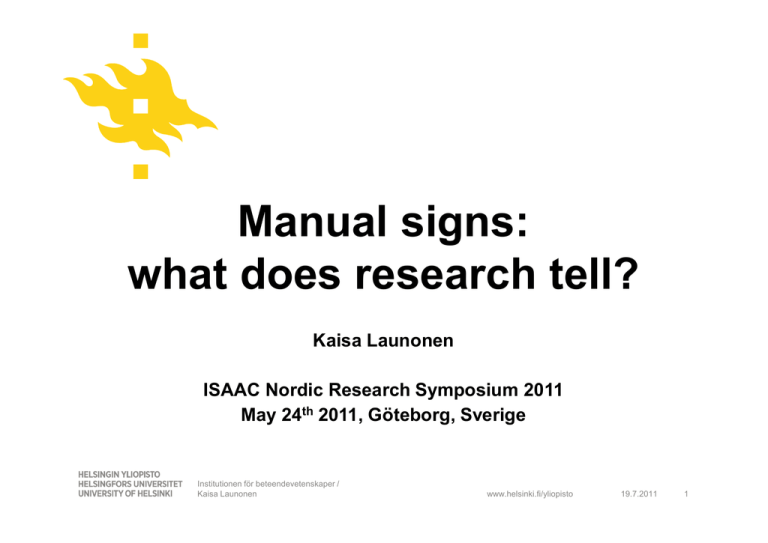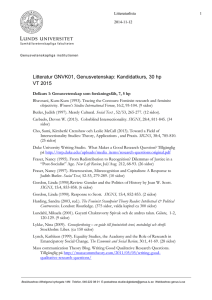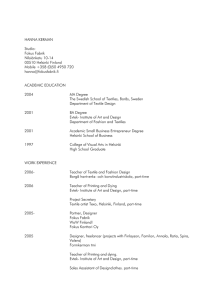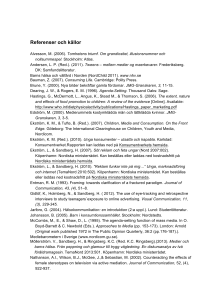Presentation as pdf
advertisement

Manual signs: what does research tell? Kaisa Launonen ISAAC Nordic Research Symposium 2011 May 24th 2011, Göteborg, Sverige Institutionen för beteendevetenskaper / Kaisa Launonen www.helsinki.fi/yliopisto 19.7.2011 1 Manual signs: what does research tell? • Top-down – bottom-up research – do theories and practices meet? • The practitioners had already been a long time up in the tree before the researchers at the bottom started to look up and try to define the species of the tree, how it had grown, was it useful, and what should be done to make it flourish. Institutionen för beteendevetenskaper / Kaisa Launonen • Basic research – applied research www.helsinki.fi/yliopisto 19.7.2011 2 In the tree Institutionen för beteendevetenskaper / Kaisa Launonen www.helsinki.fi/yliopisto 19.7.2011 3 Institutionen för beteendevetenskaper / Kaisa Launonen www.helsinki.fi/yliopisto 19.7.2011 4 Defining the species and its special qualities Institutionen för beteendevetenskaper / Kaisa Launonen www.helsinki.fi/yliopisto 19.7.2011 5 Getting up to the tree - History • The use of manual signs as an augmentative or alternative communication form for individuals who did not develop to use speech seems to have begun in the 1970s in many countries. • Examples of early Nordic approaches: • von Tetzchner, S. (1984). Facilitation of early speech development in a dysphatic child by use of signed Norwegian. Scandinavian Journal of Psychology 25, 265– 275. • Johansson, I. (1981 – 1986). Tidig språkstimulering av mongoloida barn” • Launonen, K. (1987). Viittominen – kehitysvammaisenkin vaihtoehto? [Manual signing – an alternative also for a person with learning disabilities?] J. Salminen et al. (Eds) Puheterapian vuosikirja 4 [Annals of speech therapy 4]. Suomen Puheterapeuttiliitto ry:n julkaisuja 15, 95-114. Institutionen för beteendevetenskaper / Kaisa Launonen www.helsinki.fi/yliopisto 19.7.2011 6 Manual signs today in Finland • The most common form of augmentative and alternative communication (Launonen, 2002) • Used generally with children with intellectual disabilities, autism and specific language impairment (Linjama, 2010), either as a form of early intervention, or later when a child does not develop speech as expected. • The threshold of introducing manual signs is quite low when a child does not develop speech • ”Best practice” – is there evidence and what kind of? Institutionen för beteendevetenskaper / Kaisa Launonen www.helsinki.fi/yliopisto 19.7.2011 7 Manual signs today in Finland • Linjama, T. (2010). Lasten tukiviittomien käyttö puheterapeuttien näkökulmasta [Children’s use of manual signs from speech and language therapists’ point of view]. Master’s thesis, Institute of Behavioural Sciences, University of Helsinki. http://papunet.net/tietoa/en/papulaari/opinnaytt eet/gradut/tiina-linjama.html Institutionen för beteendevetenskaper / Kaisa Launonen www.helsinki.fi/yliopisto 19.7.2011 8 What is evidence in the research on manual signs? • Research on manual signs alongside and as part of the general research on augmentative and alternative communication • Many studies and systematic reviews include both aided and unaided communication forms (e.g. Millar et al., 2006; Branson and Demchak, 2009). What is known about manual signs: what is common with other forms of augmentative and alternative communication, what is specific to the use of manual signs? When and why does it matter? Specific and specific: Individuals and groups (of individuals?) – case studies and/or group designs? Institutionen för beteendevetenskaper / Kaisa Launonen www.helsinki.fi/yliopisto 19.7.2011 9 Findings and assumptions about the benefits in manual sign use • Does not prevent or delay speech and language development, but may, instead, enhance them (e.g. Bonvillian and Nelson, 1982; von Tetzchner, 1984; Luetke-Stahlman, 1985; Miller, 1992; GoldinMeadow and Morford, 1994; Launonen, 1998; Millar, Light and Schlosser, 2006; Linjama, 2010). • Improves general interaction, communication and linguistic skills (Millar et al., 2006; Linjama, 2010). • Improves speech comprehension (Linjama, 2010). • Positive developmental effects on social and cognitive skills (Launonen, 1998, 2003). Institutionen för beteendevetenskaper / Kaisa Launonen www.helsinki.fi/yliopisto 19.7.2011 10 Findings and assumptions about the benefits in manual sign use • Enhances learning of new concepts (Linjama, 2010) • Facilitates word retrieval and diminishes word finding difficulties (Launonen and Grove, 2003; Linjama, 2010) • Supports memory and attention (Linjama, 2010). • Easy to affiliate in total communication (Bonvillian and Nelson, 1982; Launonen, 1998; Linjama, 2010). • Makes children’s unintelligible speech more intelligible (Linjama, 2010) Institutionen för beteendevetenskaper / Kaisa Launonen www.helsinki.fi/yliopisto 19.7.2011 11 Findings and assumptions about the problems in manual sign use • Memory load (Linjama, 2010) • Some family members and other communication partners are not willing to learn manual signs properly, so that they could function as a genuine communication form for the individual (Linjama, 2010) • Families and other communication partners tend to abandon manual signs too quickly after the child has started to use spoken words (Launonen, 2003) Institutionen för beteendevetenskaper / Kaisa Launonen www.helsinki.fi/yliopisto 19.7.2011 12 What research based and evidence based knowledge has been collected, in almost 40 years, about different aspects of manual signs as an alternative communication form? • ”Phonology”? • Morphology? • Lexicon? • Syntax? • Pragmatics? • Language development, language learning? • General linguistic skills? Institutionen för beteendevetenskaper / Kaisa Launonen www.helsinki.fi/yliopisto 19.7.2011 13 ”Phonetics” and articulation Sign parameters /Nicola Grove • Handshape • Location • Movement • Orientation • Handedness • Fingerspelling (from spoken language) • Facial gestures: mouth, brow, head • What should research tell about these? Institutionen för beteendevetenskaper / Kaisa Launonen www.helsinki.fi/yliopisto 19.7.2011 14 Syntax • Single-sign expressions or very short combinations form the most common syntax (e.g. Grove and Dockrell, 2000; Launonen, 2003) • Sign combinations are often strings with no underlying structure (e.g. Grove and Dockrell, 2000) • Influence of input? • Eric (Launonen and Grove, 2003) developed morphology and syntax in his manual sign system – also adult communication partners used combinations Institutionen för beteendevetenskaper / Kaisa Launonen www.helsinki.fi/yliopisto 19.7.2011 15 Language development and language learning • How should manual signs be taught to a child to make it a real communication form or a part of that? • How to incorporate central features of early interaction in interaction which includes the aim of teaching the child manual signs? • Joint attention (Clibbens, Powell and Atkinson, 2002; Clibbens and Powell, 2003) Institutionen för beteendevetenskaper / Kaisa Launonen www.helsinki.fi/yliopisto 19.7.2011 16 Future • Basic research: Definition of manual sign system(s) as alternative communication forms • Applied research: Theoretical explanations for manual communication in practice • Case studies and small-n studies → critical mass → reviews and generalisations • International research projects from different viewpoints Institutionen för beteendevetenskaper / Kaisa Launonen www.helsinki.fi/yliopisto 19.7.2011 17 References • Bonvillian, J.D. and Nelson, K.E. (1982). Exceptional cases of language acquisition. K.E. Nelson (Ed.) Children’s language. Volume 3. London: Lawrence Erlbaum. • Branson, D. and Demchak, M. (2009). The use of augmentative and alternative communication methods with infants and toddlers with diabilities: a research review. Augmentative and Alternative Communication 25, 274–286. • Clibbens, J. and Powell, G.G. (2003). Jointa attention and lexical development in typical and atypical communication. S. von Tetzchner & N. Grove (Eds.) Augmentative and alternative communication. Developmental issues (pp.28-37). London: Whurr. • Clibbens, J., Powell, G.G. and Atkinson, E. (2002). Strategies for achieving joint attention when signing to children with Down syndrome. International Journal of Language & Communication Disorders 37, 309–323. • Goldin-Meadow, S. and Morford, M. (1990). Gesture in early child language. V. Volterrra and J. Erting (Eds) From gesture to language in hearing and deaf children (pp. 26–35). Berlin: Springer. • Johansson, I. (1981 – 1986). Tidig språkstimulering av mongoloida barn” (Several publications) • Launonen, K. (1987). Viittominen – kehitysvammaisenkin vaihtoehto? [Manual signing – an alternative also for a person with learning disabilities?] J. Salminen et al. (Eds) Puheterapian vuosikirja 4 [Annals of speech therapy 4]. Suomen Puheterapeuttiliitto ry:n julkaisuja 15, 95-114. • Launonen, K. (1996). Enhancing communication skills of children with Down syndrome: early use of manual signs. S. von Tetzchner & M.H. Jensen (Eds) Augmentative and alternative communication. European perspectives (pp. 213–231). London: Whurr. Institutionen för beteendevetenskaper / Kaisa Launonen www.helsinki.fi/yliopisto 19.7.2011 18 References • Launonen, K. (2002). Tunnen, tiedän ja toteutan. Puhetta tukevaa ja korvaavaa kommunikointia käyttävän yhteisön ja puheterapeutin yhteistyön edellytykset nyky-Suomessa [I’m aware of, I know and I implement. Prerequisites for the interaction between speech therapists and communities using augmentative and alternative communication in Finland today]. Puheterapeutti 2/2002, 14–19. • Launonen, K. (2003). Manual signing as a tool for communicative interaction and language: The development of children with Down syndrome and their parents. S. von Tetzchner & N. Grove (Eds.) Augmentative and alternative communication. Developmental issues (pp. 83-122). London: Whurr. • Launonen, K. & Grove, N. (2003). A longitudinal study of sign and speech development in a boy with Down syndrome. S. von Tetzchner & N. Grove (Eds.) Augmentative and alternative communication. Developmental issues (pp.123-154). London: Whurr. • Linjama, T. (2010). Lasten tukiviittomien käyttö puheterapeuttien näkökulmasta [Children’s use of manual signs from speech and language therapists’ point of view]. Master’s thesis, Institue of Behavioural Sciences, University of Helsinki. • Luetke-Stahlman, B. (1985). Using single-subject design to verify language learning in a hearing, aphasic boy. Sign Language Studies 46, 73–86. • Millar, D.C., Light, J. and Schlosser, R.W. (2006). The impact of augmentative and alternative communication intervention on the speech production of individuals with developmental disabilities: a research review. Journal of Speech, Language and Hearing Research 49, 248–264. • von Tetzchner, S. (1984). Facilitation of early speech development in a dysphatic child by use of signed Norwegian. Scandinavian Journal of Psychology 25, 265–275. • Woll, B. and Grove, N. (1996). On language deficits and modality in children with Down syndrome: a case study of twins bilingual in BSL and English. Journal of Deaf Studies and Deaf Education 1, 271–278. Institutionen för beteendevetenskaper / Kaisa Launonen www.helsinki.fi/yliopisto 19.7.2011 19 As a researcher and a practitioner I thank you! Institutionen för beteendevetenskaper / Kaisa Launonen www.helsinki.fi/yliopisto 19.7.2011 20


